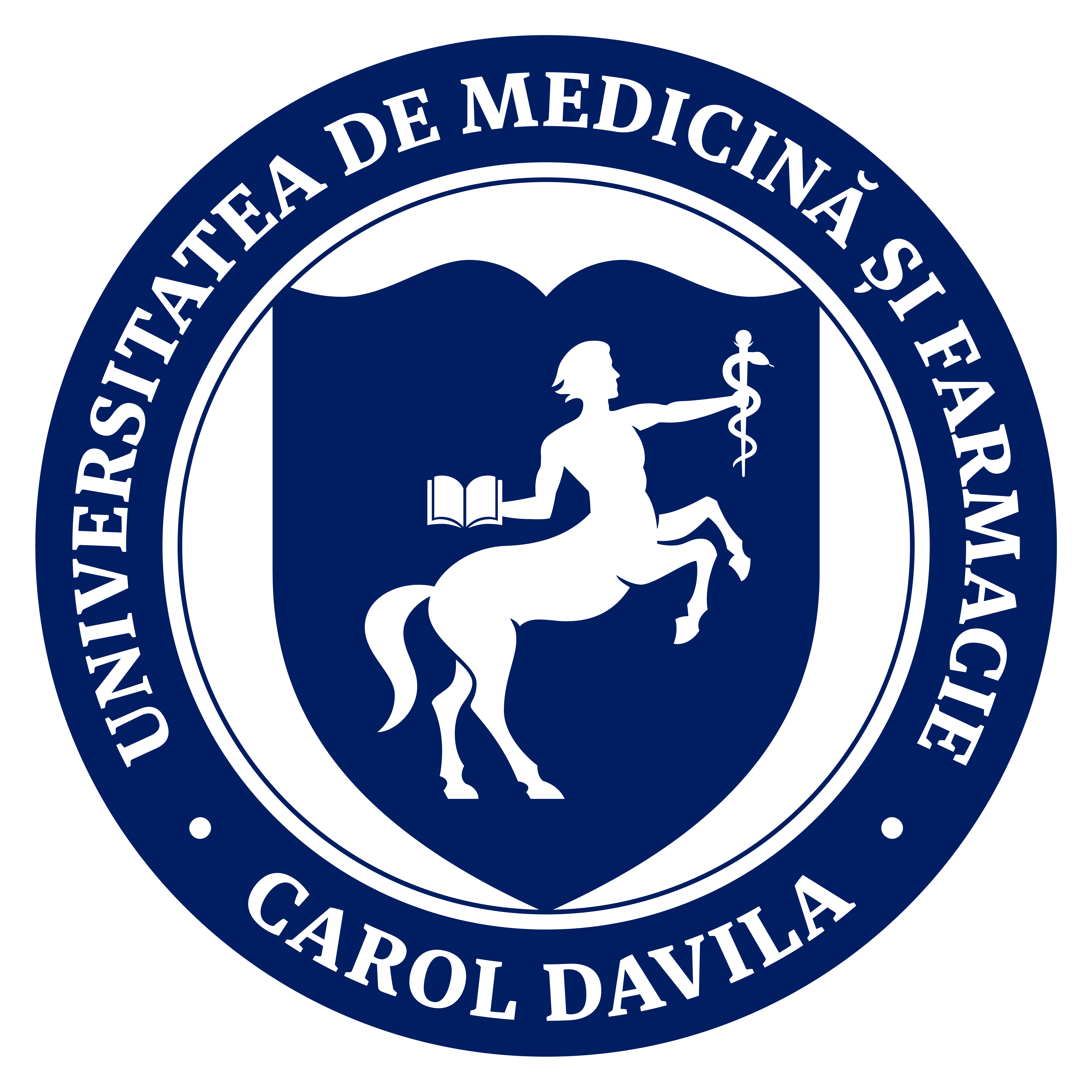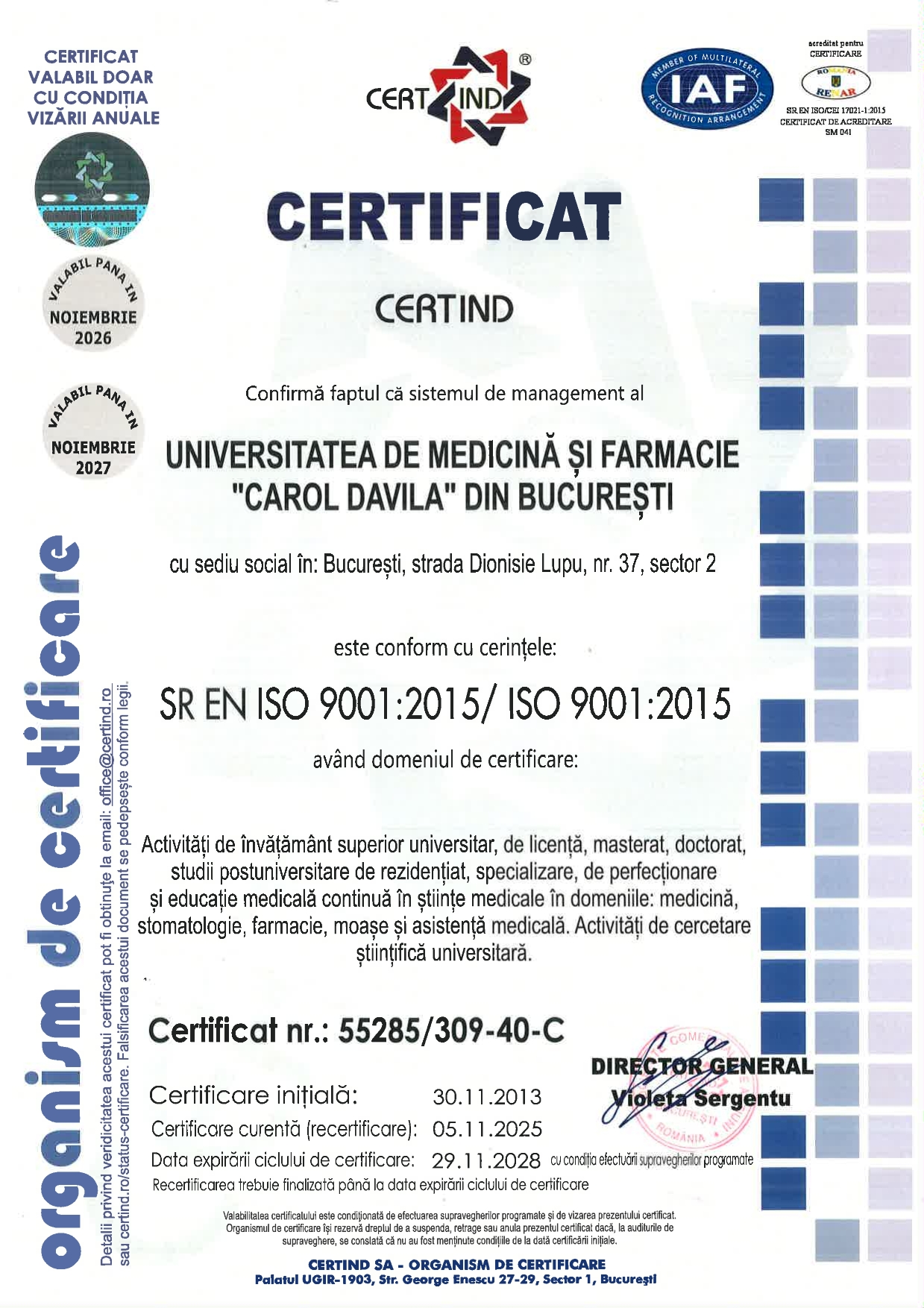[disc_cadre titlu="disc"]
- List of academic staff
- Short history of the discipline
- Descripton of the pharmaceutic activity
- Description of educational and research activities
- Useful informations for students
- Useful informations for residents
- 5-10 key words that describe the subdomains of interest for the research activity
- 5 of the most representative research projects developed
- Up until 10 of the most relevant scientific papers
[disc_cadre list="cadre"]
Pharmacodynamy was taught during the pharmaceutic studies in Bucharest since the founding of this city (1855). For many years it did not exist an independent discipline of Pharmacodynamy, the specialty knowledges being comprised in others related to it.
In 1934, in the Faculty of Pharmacy was established the Chair of Pharmacognosy and Pharmacodynamy, led by C. Kollo, as a locum tenens until 1935 when Professor dr. Gheorghe Martinescu obtained his tenure. Since 1938 Professor dr. Gheorghe Niculescu is given the tenure. Together with the accumulation of new notions in the Pharmacodynamy section, the courses of Pharmacognosy and Pharmacodynamy became more diversified, reaching the necessity of separating the two disciplines.
Thus, starting with the 1947-1948 academic year, Pharmacognosy was taught in the 4th year of studies and Pharmacodynamy was taught as a separate discipline in the 5th year of studies.
Professor dr. doc. Dumitru Dobrescu, pharmacist and pharmacology doctor, was the head of the Faculty of Pharmacy's Discipline of Pharmacodynamy in Bucharest for 30 years (1967-1997). Under his coordination, the analytical curriculum of the course is systematized in two major chapters: the general part and the special part. Professor dr. Aurelia Nicoleta Cristea followed him in leading the Chair of Pharmacology, since September 1st 1997, after the retirement of Professor Dobrescu. Nowadays, the Discipline of Pharmacology and Clinical Pharmacy is led by Professor dr. Simona Negres.
Within the discipline there is a continuous activity of Clinical Pharmacy, pharmaceutical specialty found at the border between Medicine and Pharmacy, being responsible for the assurance of an efficient and safe pharmacotherapy for the patient.
Through or activity we are permanently following three criteria: maximization of the therapeutic effect of the drugs through individualization of each patient's therapy, minimization of the risk of apparition of adverse reactions and the choosing of the treatment based on the cost/efficiency criterion.
These activities are done in close collaboration with the clinical pharmacists hired in hospital pharmacies and in the community pharmacies and implies the participation of the students of the Faculty of Pharmacy that are in the terminal years and those that are residents in the Clinical Pharmacy specialty .
We intend to start interregional projects that are aimed towards the following aspects:
- Analysis of the consumption of nutritive supplements in Romania and detect the interactions between them and each patient's treatment;
- Analysis of the elderly patient's medication taking into consideration that this category of age has three modalities of suboptimal prescription: „overuse", "misuse", "underuse";
- Implication in a complex programme for increasing the adherence and persistence to chronic treatment;
- Establishing a Pharmacovigilance center and active involvement in this field;
The didactic activity is happening through the course of three years of study and consists of teaching general pharmacology, pharmacology of devices and systems and pharmacotherapy notions. In this educational process the accent is on the correlation of the data regarding drugs' mechanisms of action with the therapeutic indications and of the pharmacokinetics aspects taking into consideration that these influence the dosage of the active substances. Also, during the lectures the focus is on the interactions between drugs, drugs and food and drugs and nutritive supplement.
In the process of postgraduate training are proposed courses that aims for the actualization of the informations in the field of drugs, the accent being placed on the newly authorized molecules, on the biological therapy and on the data of pharmacovigilance of older molecules.
The scientific research was made in close colaboration with different disciplines of the Faculties of Pharmacy in Bucharest or in other cities in the country and with other institutions along with which we have participated in research projects: The National Insitute of Chimico-Pharmaceutic development, Faculty of Veterinary Medicine, Faculty of Biology. The research directions of the discipline are:
- Preclinical researches about the variability of the pharmacologic answer in analgezia tests, with three subdirectories:
- Variability of the pharmacologic response depending on the psychoneuroendocrine typology
- Variability of the pharmacologic response in neuropathic pain
- Variability of the response to pain through the administration of newly synthetized organic compounds or of the active principles of vegetal nature
- Preclinical researches regarding the variability of the pharmacologic response in tests that investigate the action of psychotropic substances
- Experimental pharmacologic researches regarding the efficiency of the newly synthesized substances or of the active principles of vegetal nature in diabetes mellitus and dyslipidemia
- Experimental pharmacokinetics researches regarding the estimation of the pharmacokinetic profile of some compounds of inorganic nature
- Pharmacologic and toxicologic screening for determining the pharmacodynamic parameters of interest (place of action, latency of the effect, duration of the action) and of the acute toxicity (expressed through DL50) for newly synthesized organic substances or for active principles of vegetal nature.
There were created and validated 5 experimental pharmacologic models, that were later used in the achievement of researches of some projects and PhD theses:
- The model for inducing depression with reserpine in the mouse, starting from the idea that depression as a phenomenon is very hard to quantify in laboratory animals, in the absence of verbal scales. We used as a pharmacologic agent reserpine that produces cathecolamine depletion at the central level and can induce from a biochemical point of view a depressive syndrome at the animal.
- The experimental model of inducing hyperexcitability and manifestations of psychotic type through administration of selegiline and levodopa. These substances raise semnificantly the cerebral concentration of dopamine, with the apartion of a syndrome of psychotic type. The model can be used for testing antipsychotic substances that have an antidopaminergic mechanism.
- Experimental model for inducing aloxanic diabtes at the mouse, identifying the dose that produces an optimum response when it comes to the percentage of animals from the community at which the diabetes installs, and also the rate of survival of diabetic animals, without suplimentary administration of insulin.
- Experimental model for inducing rheumatoidic poliarthritis with Freund adjuvant to the mouse, on which we could evidentiate the positive radiologic modifications of the metotrexate conditioned under a liposome form, with a reduced systemic toxicity.
- Experimental model for inducing neuropathic pain through administering paclitaxel to the mouse, which permitted the attainment of an intense and durable hyperalgic response (maintained for approximately 3 weeks after interrupting the chimiotherapic). The animal model permitted the evaluation of the antialgic effect of some active substances administered alone or in association.
- Experimental model for hypersensibilization to contact at mice BALB/c, using as an alergen 2,4-dinitrofluorobenzene (DNFB). The alergic phenomenon was evaluated thorugh determining the thickness of the left ear with the help of a digital micrometer. This method permitted the determination of the DE50 of some hydro-alcoholic dried extracts, with the property of reducing the reaction of hypersensibilization.
In the activity of the Discipline fo Pharmacology and Clinical Pharmacy are considered the following objectives:
- Acquiring knowledge about the general notions corresponding to the fundamental branches: pharmacokinetics, pharmacodynamy, pharmacotoxicology and applicative: pharmacography, pharmacotherapy, pharmacoepidemiology of Pharmacology.
- Acquiring knowledge about the bioethics legislation, the correct maneuvres of immobilizing and administering of substances that will be tested in the experiments done on the laboratory animal.
- Substantiation of the knowledges concerning therapeutic indications of drugs, based on the understanding of mechanisms of action at molecular, cellular and functional level of them.
- Substantiation of prescribing drugs on knowing the pharmacokinetic parameters.
- Substantiation of counter-indications and precautions in pharmacotherapy on the basis of adverse reactions and of possible iatrogenic diseases.
- Counseling of the patient regarding the way and optimum moment for administering of the drug (related to nycthermeral and circadian biorhythm), of the therapeutic indications and of the adverse reactions.
- Counseling of the patient regarding the use of OTC drugs.
Targets of the Clinical Pharmacy include aspects regarding:
- Optimization and individualization pharmacotherapy on the basis of the clinical and pharmacokinetic criteria.
- Identifying the interactions drug/drug, drug/nutriment, ethical drug/OTC drug, drug/food supplement, drug/ pathology.
- Adjusting the doses depending on the biometric parameters or the insufficiency of comb-out ways.
- Monitoring the therapy on the pharmacokinetic criterion (monitoring the plasmatic concentration of the drug, in the hospital).
- Identification of "in vitro" incompatibilities (syringe, IV perfusion)
- pharmacologic and toxicologic screening
- neuropathic pain
- dyslipidemia
- diabetes mellitus
- psychotropic substances
- CEEX 51/2005: „NOI STRUCTURI CU POSIBILĂ ACŢIUNE ANTIDIABETICĂ/ANTIOBEZITATE DIN CLASA AGONIŞTILOR RECEPTORILOR BETA-3 ADRENERGICI; CERCETĂRI MULTIDISCIPLINARE” perioada: 2005 – 2007.
- PC NR. 1750 ”SINTEZA ŞI EVALUAREA FARMACOLOGICĂ A NOI COMPUŞI, PENTRU IMPLEMENTAREA DE TERAPIA MODERNE ÎN TRATAMENTUL OBEZITĂŢII ŞI/SAU DIABETULUI DE TIP 2: CERCETĂRI PREPARATIVE, STRUCTURĂ, SCREENING FARMACOLOGIC” perioada: 2008 – 2011.
- PN II 952/13.05.2013: “OBŢINEREA PRIN METODE BIOTEHNOLOGICE A UNOR NOI TIPURI DE VECTORI PENTRU PRINCIPII FITOTERAPEUTICE ŞI MODELAREA MECANISMELOR DE CEDARE A ACESTORA”, perioada: 2014 – 2016.
- PN II Contract 15 BM/2016-Cooperare Africa de Sud: “SELF-EMULSIFYING DELIVERY SYSTEM FOR NEW METAL COMPLEXES AS MATERIALS WITH POTENTIAL HEALTH USE”, perioada: 2016 – 2017.
- Negreş S, Zbârcea CE, Arsene A, Chiriţă C, Buzescu A, Velescu BŞ, Ştefănescu E, Şeremet OC, Nicolescu F. Experimental pharmacological model for inducing and quantifying depression in mouse. Farmacia 2013; 61(6): 1102-1116. [ISSN: 0014-8237; IF (2014): 1,005].
- Ancuceanu R, Dinu M, Hovaneț MV, Anghel AI, Popescu CV, Negreș S. A Survey of Plant Iron Content – A Semi-Systematic Review. Nutrients 2015; 7: 10320–10351. [ISSN 2072-6643; IF: 3,27].
- Buzescu A., Negreș S., Lefter M., Velescu B.Ș., Ștefănescu E., Chiriță C., Nicolescu F. The influence of some psychotropic substances on conditioning using an active avoidance paradigm. Farmacia 2014; 62(1):202-210. [ISSN 0014-8237; IF (2014): 1,005].
- Bărbuceanu ŞF, Băncescu G, Şaramet G, Drăghici C, Rădulescu SF, Ionescu A, Negreş S. Synthesis and bological evaluation of some new N 1 -[4- (4-chlorphenylsulfonyl)benzoyl]-N 4 -(aryl)- thiosemicarbazides and products of their cyclization. Heteroatom Chemistry 2013 July; 24(4): 309-321 [ISSN: 1098-1071; IF:1,577].
- Negreş S, Chiriţă C, Moroşan E, Arsene AL. Experimental pharmacological model of diabetes induction with alloxan in rat. Farmacia 2013; 61(2): 313-323. [ISSN: 0014-8237. [ISSN: 0014-8237; IF: 1,251]
- Ştefănescu E., Negreş S., Chiriţă C., Zbârcea C.E., Neagu R. Pharmacological screening regarding the influence of some newly synthesized beta-phenylethylamines on the systolic and diastolic blood pressure in rats. Farmacia, 2012; 60(5):642-651 [ISSN: 0014-8237; F.I.: 0,578; S.I.: 0,040]
- Zbârcea CE, Negreş S, Chiriţă C. Gabapentin, alone and associated with tramadol reduces peripheral paclitaxel-induced neuropathy in rats. Farmacia, 2011; 59(3):414-423 [ISSN: 0014-8237; F.I.: 0,669; S.I.: 0,043]
- Chiriţă C, Cristea AN, Militaru M, Negreş S, Zbârcea CE, Nuţă DC. Pharmacological evaluation of acute and subacute toxicity and antidepressant effect after acute administration of novel N-substituted benzamides. Farmacia, 2010; 58(1):21-28 [ISSN: 0014-8237; F.I.: 0,850; S.I.: 0,154]
- Velescu BS, Anuţa V, Uivaroşi V. Pharmacokinetic evalution of a novel ruthenium-ofloxacin complex, as potential therapeutic agent. Farmacia 2012, 62 (5), 1009-1024; [ISSN 0014-8237; F.I.: 0.578]
- Badea M, Patrascu F, Cerc Korošec R, Bukovec P, Raita M, Chifiriuc MC, Marutescu L, Bleotu C, Velescu B, Marinescu D, Uivarosi V, Olar R. Thermal, spectral, magnetic and biologic characterization of new Ni(II), Cu(II) and Zn(II) complexes with a hexaazamacrocyclic ligand bearing ketopyridine moieties. J Therm Anal Calorim 2014;118(2): 1183-1193; [ISSN 1388-6150; F.I.: 2.206]
- Brevet de invenţie: „Hidrogel conţinând indometacin şi procedeu de prepaprare al acestuia” – 118930/ 2009 [autori: Ghica MV, Popa L, Negreş S, Chiriţă C].
- Brevet de invenţie:“Compuşi de oxovanadiu (IV) cu flavone, procedee de obţinere şi utilizare terapeutică.00126184 /.2013 [autori: Aldea V. Negreş S, Uivaroşi V, Velescu BŞ, Olar MR]



